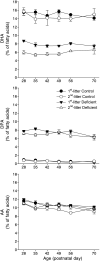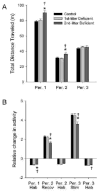Developmental effects of dietary n-3 fatty acids on activity and response to novelty
- PMID: 20457171
- PMCID: PMC2923479
- DOI: 10.1016/j.physbeh.2010.04.038
Developmental effects of dietary n-3 fatty acids on activity and response to novelty
Abstract
Insufficient availability of n-3 polyunsaturated fatty acids (PUFA) during pre- and neonatal development decreases accretion of docosahexaenoic acid (DHA, 22:6n-3) in the developing brain. Low tissue levels of DHA are associated with neurodevelopmental disorders including attention deficit hyperactivity disorder (ADHD). In this study, 1st- and 2nd-litter male Long-Evans rats were raised from conception on a Control diet containing alpha-linolenic acid (4.20 g/kg diet), the dietarily essential fatty acid precursor of DHA, or a diet Deficient in alpha-linolenic acid (0.38 g/kg diet). The Deficient diet resulted in a decrease in brain phospholipid DHA of 48% in 1st-litter pups and 65% in 2nd-litter pups. Activity, habituation, and response to spatial change in a familiar environment were assessed in a single-session behavioral paradigm at postnatal days 28 and 70, inclusive. Activity and habituation varied by age with younger rats exhibiting higher activity, less habituation, and less stimulation of activity induced by spatial novelty. During the first and second exposures to the test chamber, 2nd-litter Deficient pups exhibited higher levels of activity than Control rats or 1st-litter Deficient pups, and less habituation during the first exposure, but were not more active after introduction of a novel spatial stimulus. The higher level of activity in a familiar environment, but not after introduction of a novel stimulus is consistent with clinical observations in ADHD. The observation of this effect only in 2nd-litter rats fed the Deficient diet suggests that brain DHA content, rather than dietary n-3 PUFA content, likely underlies these effects.
Copyright 2010 Elsevier Inc. All rights reserved.
Figures







Similar articles
-
Maternal parity and diet (n-3) polyunsaturated fatty acid concentration influence accretion of brain phospholipid docosahexaenoic acid in developing rats.J Nutr. 2007 Jan;137(1):125-9. doi: 10.1093/jn/137.1.125. J Nutr. 2007. PMID: 17182812
-
Decreased brain docosahexaenoic acid during development alters dopamine-related behaviors in adult rats that are differentially affected by dietary remediation.Behav Brain Res. 2004 Jun 4;152(1):49-57. doi: 10.1016/j.bbr.2003.09.029. Behav Brain Res. 2004. PMID: 15135968
-
Effect of dietary docosahexaenoic acid on biosynthesis of docosahexaenoic acid from alpha-linolenic acid in young rats.J Lipid Res. 2008 Sep;49(9):1963-80. doi: 10.1194/jlr.M800117-JLR200. Epub 2008 May 9. J Lipid Res. 2008. PMID: 18469302 Free PMC article.
-
Docosahexaenoic acid (DHA): an ancient nutrient for the modern human brain.Nutrients. 2011 May;3(5):529-54. doi: 10.3390/nu3050529. Epub 2011 May 10. Nutrients. 2011. PMID: 22254110 Free PMC article. Review.
-
Can adults adequately convert alpha-linolenic acid (18:3n-3) to eicosapentaenoic acid (20:5n-3) and docosahexaenoic acid (22:6n-3)?Int J Vitam Nutr Res. 1998;68(3):159-73. Int J Vitam Nutr Res. 1998. PMID: 9637947 Review.
Cited by
-
Maternal omega-3 fatty acid intake during neurodevelopment does not affect pup behavior related to depression, novelty, or learning.BMC Res Notes. 2018 Nov 15;11(1):812. doi: 10.1186/s13104-018-3915-3. BMC Res Notes. 2018. PMID: 30442183 Free PMC article.
-
Sensorimotor behavioral tests for use in a juvenile rat model of traumatic brain injury: assessment of sex differences.J Neurosci Methods. 2011 Aug 15;199(2):214-22. doi: 10.1016/j.jneumeth.2011.05.008. Epub 2011 May 11. J Neurosci Methods. 2011. PMID: 21600923 Free PMC article.
-
Beneficial effects of omega-3 fatty acid supplementation in schizophrenia: possible mechanisms.Lipids Health Dis. 2020 Jul 3;19(1):159. doi: 10.1186/s12944-020-01337-0. Lipids Health Dis. 2020. PMID: 32620164 Free PMC article. Review.
-
Maternal diet of polyunsaturated fatty acid altered the cell proliferation in the dentate gyrus of hippocampus and influenced glutamatergic and serotoninergic systems of neonatal female rats.Lipids Health Dis. 2016 Apr 5;15:71. doi: 10.1186/s12944-016-0236-1. Lipids Health Dis. 2016. PMID: 27048382 Free PMC article.
-
N-3 (Omega-3) Fatty Acids: Effects on Brain Dopamine Systems and Potential Role in the Etiology and Treatment of Neuropsychiatric Disorders.CNS Neurol Disord Drug Targets. 2018;17(3):216-232. doi: 10.2174/1871527317666180412153612. CNS Neurol Disord Drug Targets. 2018. PMID: 29651972 Free PMC article. Review.
References
-
- Lavigne JV, Gibbons RD, Christoffel KK, Arend R, Rosenbaum D, Binns H, Dawson N, Sobel H, Isaacs C. Prevalence rates and correlates of psychiatric disorders among preschool children. J Am Acad Child Adolesc Psychiatry. 1996;35:204–214. - PubMed
-
- Skjoldager P, Fowler SC. Scopolamine attenuates the motor disruptions but not the attentional disturbances induced by haloperidol in a sustained attention task in the rat. Psychopharmacology (Berl) 1991;105:93–100. - PubMed
-
- Brockel B, Fowler S. Effects of chronic haloperidol on reaction time and errors in a sustained attention task: Partial reversal by anticholinergics and by amphetamine. The J Pharmacol Exp Ther. 1995;275:1090–1098. - PubMed
-
- Kornetsky C. The use of a simple test of attention as a measure of drug effects in schizophrenic patients. Psychopharmacologia. 1972;24:99–106. - PubMed
-
- Chee P, Gordon L, Schachar R, Lindsay P, Wachsmuth R. Effects of event rate and display time on sustained attention in hyperactive, normal, and control children. J Abnorm Child Psychol. 1989;17:371–391. - PubMed
Publication types
MeSH terms
Substances
Grants and funding
LinkOut - more resources
Full Text Sources
Medical

